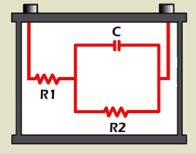You would be looking for something in the >>25 kHz range for lead sulphate crystals vibrations .
**broken link removed**
If measurement vibration pickup gets EMI crosstalk from current and mirror test would show more reflectivity as the dull sulphate coating is removed giving rise to granular reflections diffused brighter reflections. But emitter calibration is key. Detectors are very stable but emitters are not.
Also cell spectroscopic test using a Network Analyzer. (ac coupled) between cells might be more effective from 10k to 1MHz using s11 and s12 measurements with a large n ratio instrument transformer to go from ESR range to 50 Ohms.
Plate analysis under SEM 10k magnification of the crystallography certainly will show pronounced visible effects that coincide with restored specific gravity.
**broken link removed**
If measurement vibration pickup gets EMI crosstalk from current and mirror test would show more reflectivity as the dull sulphate coating is removed giving rise to granular reflections diffused brighter reflections. But emitter calibration is key. Detectors are very stable but emitters are not.
Also cell spectroscopic test using a Network Analyzer. (ac coupled) between cells might be more effective from 10k to 1MHz using s11 and s12 measurements with a large n ratio instrument transformer to go from ESR range to 50 Ohms.
Plate analysis under SEM 10k magnification of the crystallography certainly will show pronounced visible effects that coincide with restored specific gravity.



